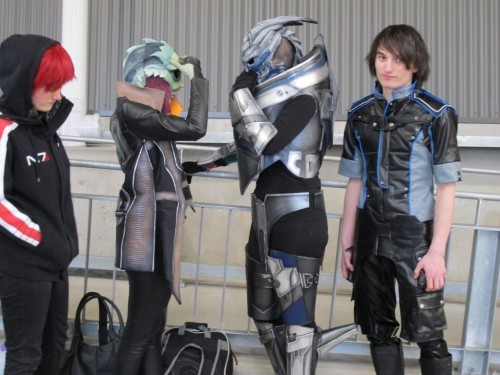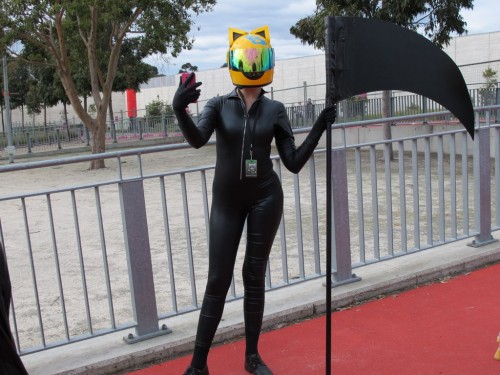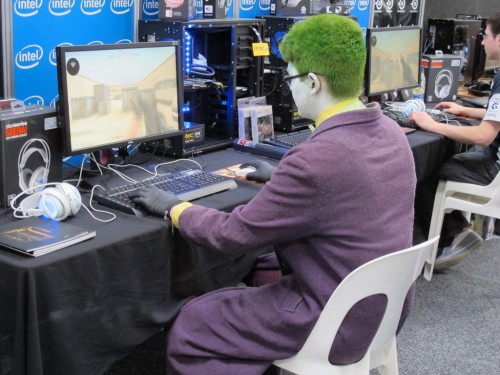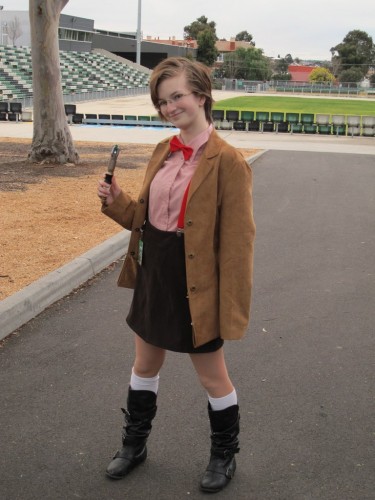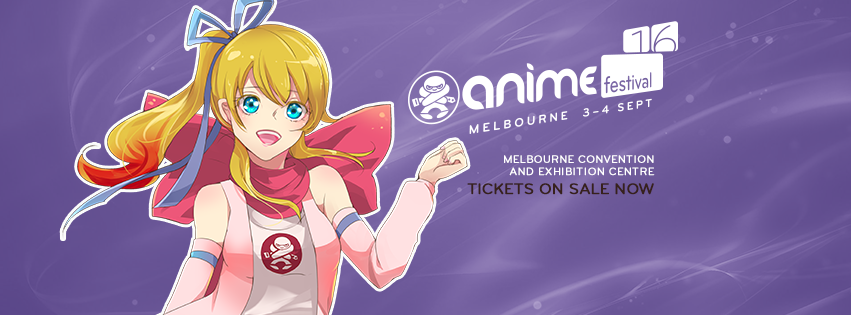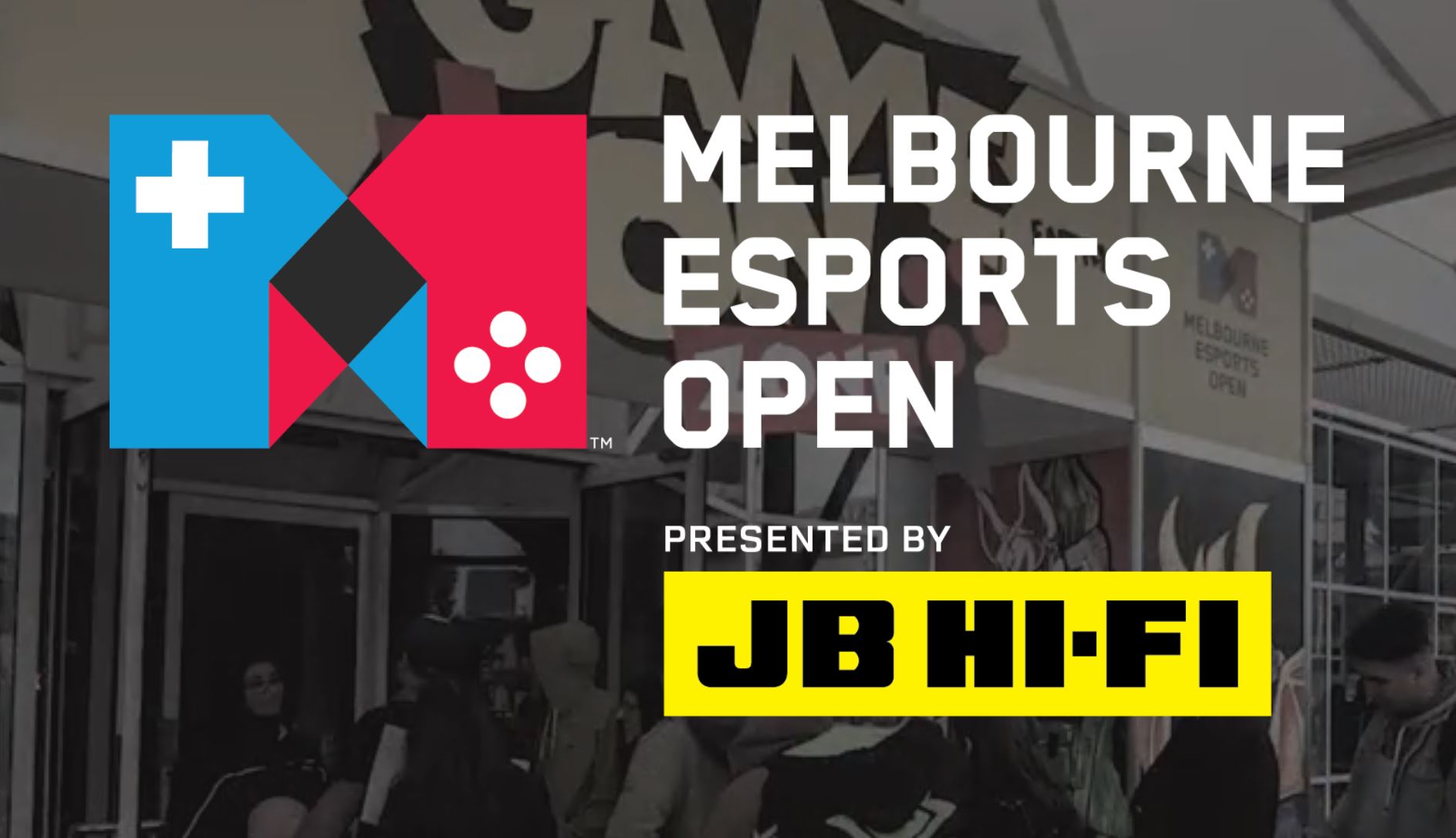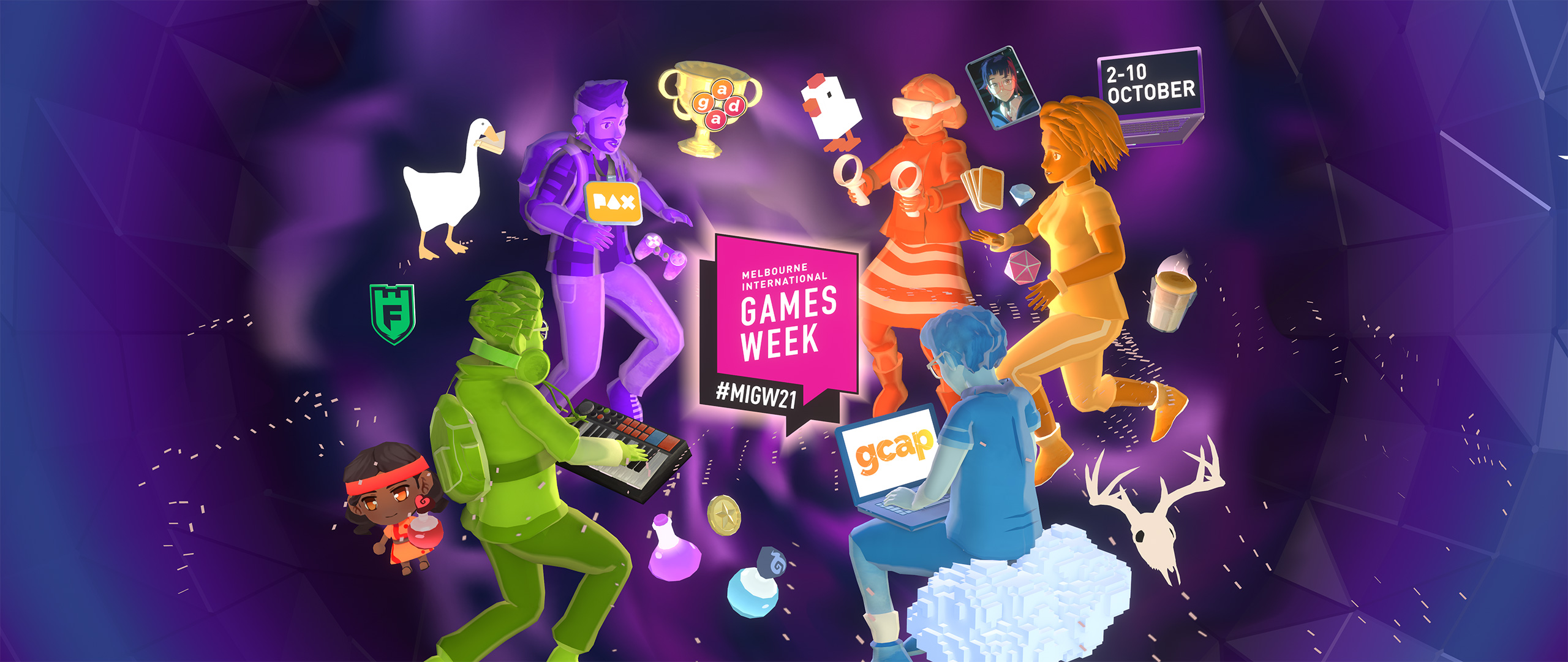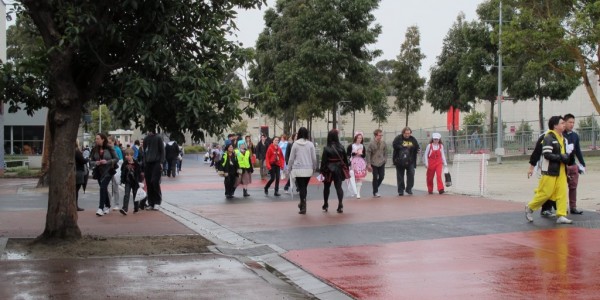
On a weekend, late in August, something special happens in Melbourne. People who you would see travelling to and from work during the week, dressed like any other person, change. They put on different clothes, change their hair colour, wear makeup. They tranform themselves into as close an approximation of their favourite anime (and, more recently, popular culture) characters.
Then they head to the Showgrounds. For one weekend, they get to be someone else. For over ten years now, the Melbourne Anime Festival, more commonly known as Manifest, has been bringing them together, offering them somewhere to meet others and express themselves.
Manifest has the clear distinction of being Australia’s first true anime convention. It began in 2000, a one-and-a-half day event in the Old Arts Building at Melbourne University. Evolving from a series of screenings marathons run by local anime clubs, the first Manifest attracted a few hundred people. The following year a few hundred more showed up to the same place for a full two days. That year even saw traders for the first time, crunched together in a narrow corridor at the southern end of Old Arts.
From there, Manifest has grown and grown. First to a second building at the university (Economics & Commerce), then a third (originally Wilson Hall, later the Union building) and then, in 2009, to the Melbourne Showgrounds. Each year, the committee looked on incredulously as more and more people showed up. From a few hundred in 2000, to well over ten thousand a decade later.
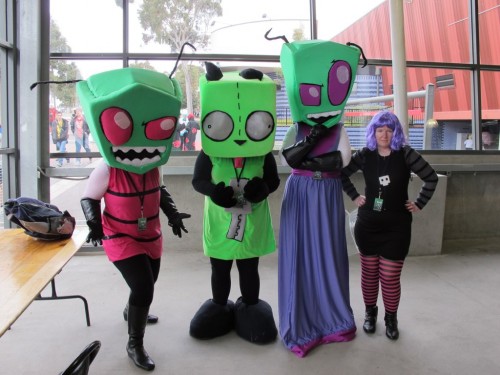
Behind it all has been a dedicated committee of volunteers and organisers who manage, every year, to somehow pull the event off. Organising the event is a year-long occupation, and it can be chaotic, emotionally and physically draining and, in a few cases, hazardous to health. Committee meetings can be gruelling, with large numbers of people all trying to get approval to do the little things they need to do to make their department run. There are arguments, fights and, very occasionally, agreements.
That’s not to say that the Manifest organising committee (or MOC, as it’s affectionately known these days) is a bad experience. It can be— and I’m speaking from experience, here— exhilarating, and sometimes even fun. Seeing Manifest actually happen is, as any committee member will tell you, the most satisfying experience.
Outsiders sometimes find it hard to fathom the size of Manifest. When the convention first moved to the showgrounds in 2008, then-Melbourne train operator Connex couldn’t be convinced to run trains to the showgrounds. When the trams started filling to far beyond capacity, Yarra Trams had to put on extra services. The following year, new operator Metro ran trains over the weekend.
The RASV, too, didn’t quite seem to recognise just how big the event was. To them, Manifest was amateur, a junior event looking to make it into the big time. When it pulled nearly 10000 people over three days, they sat up and took notice. This little niche event that, the year before had been running into venue capacity problems at Melbourne University, was big. Big enough, it turned out, to be able to move into much larger digs at the Showgrounds in 2012.
For me, Manifest is always a whirl of events, screenings and meeting people I only ever see once a year. My Manifest friends are always nice, amicable people, and while we occasionally promise to catch up outside of the event, it never quite seems to happen. We all lead separate lives, and we all only come together for that one weekend in August.
We all have different reasons for going. Manifest has many, many events over the weekend, and they all attract different kinds of people. In the early years, Manifest was strictly about anime, but around 2004 and 2005, the event began expanding. Adding video games opened up an entire side of Japanese popular culture that had largely been ignored until that point. Later we added more cultural events, offering a way for Manifest attendees to experience Japanese traditions such as the tea ceremony.
A large majority of people come to Manifest for the cosplay. The cosplay contests draw huge crowds, and are always really fun to watch. In the early years, the contests had the annoying habit of running over time, often by a few hours, until strict limits were put in place to keep the cosplay events within time limits, and entertaining.
There are perennial favourites for cosplayers. The longest running of these is probably Sailor Moon, and there has yet to be a Manifest where it isn’t possible to assemble a group of girls all dressed as at least the five Inner Senshi. Usually it’s possible to assemble every version of Sailor Moon herself, too. Other favourites include popular shows such as Pokemon, Dragon Ball Z, Bleach and Naruto, and it’s almost impossible to swing a fake sword without hitting at least a few from each of those shows. You can generally count on at least a couple of Studio Ghibli characters. I’ve seen at least one Kiki for the last five years running, and there’s always a ridiculously elaborate Totoro on show.
It’s not just anime, either. As Manifest expanded, so too did the cosplayers on show. Final Fantasy has always been well-represented, but other titles, such as Team Fortress 2, Halo Super Mario Bros, the Persona games and Silent Hill have become more common in recent years. This year saw a significant surge in the number of Mass Effect cosplayers, with no fewer than three Garruses (Garrii?) on Saturday, and at least one Thane Krios (I didn’t see any Tali cosplayers, sadly).
One aspect of Manifest that makes it unique among Australian conventions is its intensive screening schedule. No other con shows as much anime, in as many theatres, as Manifest does. In the early days, Manifest would fill five or six lecture theatres at Melbourne University with anime, supplied on VHS cassettes (This was before digital fansub distribution became popular) by a local fansubber. The move to the showgrounds cut the number of theatres to three, however it also saw Manifest ‘go legit’, by cutting out fansub screenings and getting proper screening rights for its titles.
This change led to some consternation from attendees who felt that Manifest wasn’t showing ‘current’ screenings, but it also allowed greater flexibility in what could be screened. The two sponsored theatres— one each from Siren and Madman— have become showcases for the respective companies, giving them a unique space to show off their catalogue, as well as upcoming titles.
Perhaps the most unique of Manifest’s theatres has been the Peppa-chan Lounge. Named for the con’s mascot, the Peppa-chan Lounge started out as a smaller theatre to fit in niche titles and older series that may not pull the kind of audience they could pull in the main theatres. It’s also been home to some of the greatest moments in Manifest history. 2009 saw the introduction of live-action movies to Manifest, and the Peppa-chan Lounge made the perfect proving ground for them, bringing Lovely Complex, NANA and GTO The Movie to the convention to much applause. Despite its smaller size, there have been occasions where the Peppa-chan Lounge has packed out more than the other theatres.
2012 saw the addition of a new theatre, the Hanabee theatre. With the move to a longer screenings format (fewer anime, but more episodes of them), this allowed Australia’s newest anime distributor to showcase its biggest titles, such as ToraDora and saw a fully American live-action production screen for the first time at Manifest in the form of The Guild.
There are those that argue that this somewhat dilutes Manifest’s commitment to anime and Japanese culture, and while that might be true, branching out to cover things that anime fans also like (but which aren’t necessarily anime-related) will only help Manifest evolve and grow in the coming years. It offers something up for the broader community, making it not just for Melbourne’s anime fans, but for Melbourne itself, showing the world that this sport-loving city has culture, too.
When Manifest first started, panels were a way of justifying an educational component, allowing the con easier access to the facilities at Melbourne university. The panel stream at Manifest has always had something of a “there because it has to be” feel to it, and the coordinators behind it have often been some of the most harried and stressed members of the committee. Some panels have developed into fixtures over the years, such as the so-big-it-filled-a-theatre yaoi panel, while others that were once fixtures have fallen by the wayside (when, exactly, did Manifest last run Anime 101?).
Panels are also important for the anime distributors, with Madman’s panel always drawing international attention. For the first time in a long time, Madman unloaded all the big announements at Manifest this year, revealing Eureka Seven AO, Michiko to Hatchin and the latest Rurouni Kenshin production. These announcements, though major, paled in comparison with newcomer Hanabee’s announcement of recent hit Bodacious Space Pirates, an instant-classic series from the makers of Nadesico and Stellvia.
This year saw a vastly expanded video game area, introducing PC gaming to Manifest for the first time. While the focus on gaming was similar as in previous years— mostly fighting games, with a few flavor-of-the-month other titles thrown in— it was as popular as ever. There was also a retro gaming setup, though, sadly, whoever did it had no idea about how terrible old consoles look when running on modern HDTVs. I would highly recommend that they dig up some older CRTs for the proper retro experience next year.
This year also saw the biggest and most well-planned maid cafe operation yet. The Manifest Maid Cafe has become something of an institution since the move to the showgrounds, however the planning behind it has always been quite troublesome, partially due to the issues Manifest has always had with the showgrounds’ preferred catering service, and partially due to just how difficult it is to set something like this up. This year saw the Maid Cafe get full support from Hanabee, and everyone from the just-starting anime company was pitching in. Even Eric Cherry, Hanabee’s CEO was working the tills. Eric guided me through the cafe on Saturday, and it genuinely felt like a piece of Akihabara had been carved off and placed in the trader’s hall.
If you find maid cafes a little creepy (and some do), then the other food options were fairly limited. There was a standard showgrounds burger/chips/drinks place, who’s food was… edible. There was Nando’s if you felt like spending far more money than was really necessary, and a donuts and coffee place. Japanese food was, sadly, limited to a takoyaki stall. For a convention ostensibly about Japanese things, the limited amounts of Japanese food on offer is frustrating. I fully understand that the reasons for the limited selections are, again, due to the restrictions imposed by the RASV, but surely after four years, something can be worked out to get at least a Sushi Sushi or Yoyogi or some other franchise that specialises in thematically appropriate food?
More generally, traders was an improvement on previous years, with a bigger range, and more smaller fan traders than in previous years. The move to a larger building helped solve the problem of narrow, crowded aisles (as did moving Tamarket away from opposite Madman), and a better overall layout made it easier to find similar traders. I do note that the shops run by former Manifest convenors Avi Bernshaw and Michael Lanyon were prominently placed.
Alongside Madman and Tamarket, Lanyon’s Critical Hit store was as popular as ever, and some of that clearly fed into those stalls around him. A lot of familiar trader faces were there again, as well as a couple of new ones. I was saddened to note that long-time Manifest supporter Animezone was absent this year.
Every so often, Manifest goes through something of a generational change among its organisers. The last time it happened, it resulted in the disastrous 2008 convention, where the committee’s leadership actually attempted to shut the convention down, believing it couldn’t be run. It wouldn’t surprise me to discover a similar battle having taken place behind the scenes this year either. While there was nothing quite so obnoxious as last year’s Peppa-chan (who verbally abused several attendees), there was definitely obvious discord amongst the committee that could easily be seen if you looked a little below the surface.
As I said earlier, Manifest sometimes tends to run despite the best efforts of the committee, and this year definitely felt that way. Events, screenings and other fixtures went off well enough that most attendees would have been satisfied with their weekends. There was some pre-con worry about the price, but Manifest’s price has gone up every year, and each time it can best be justified by the phrase “economic realities of running an anime convention”.
The social aspect of Manifest— the ability to meet up with others who like the same things we like— are, really, the ultimate reason everyone comes. Manifest has built this fabric up over many years, and it will take more than a broken committee to change that. People go to Manifest because it’s the beacon of a community in Melbourne, and as it expands and branches out, more and more of these niche groups come to it, and find others they can relate to. We all meet up once a year for Manifest, but we all go away glad that we were able to check in on an old friend.
I look forward to Manifest 2013.

